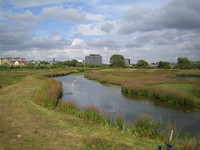Natural productsWe use a lot of natural products from wetlands, including fish, shellfish, blueberries, cranberries, timber, and wild rice. In addition to this, medicines are derived from wetland soils and plants. Many of the nation's fishing and shellfishing industries harvest wetland-dependent species; the catch is valued at $15 billion a year. In the Southeast, for example, nearly all the commercial catch, and over half of the recreational harvest, are fish and shellfish that depend on the estuary-coastal wetland system. Louisiana's coastal marshes, produces an annual commercial fish and shellfish harvest of 1.2 billion pounds, worth $244 million in 1991. Wetlands are the habitat for fur-bearers, like the muskrat, beaver, and mink as well as reptiles such as alligators. The nation's harvest of muskrat pelts alone, is worth over $70 million annually. |
Recreation and aestheticsWetlands have recreational, historical, scientific, and cultural values. More than half of all U.S. adults (98 million) hunt, fish, bird watch or photograph wildlife. They spend a total of $59.5 billion annually. Painters and writers continue to capture the beauty of wetlands on canvas and paper, or through (photo)cameras and sound recorders.
|
More about:
More than one third of the US threatened species live in wetlands.
Wetlands are some of the most biologically productive natural ecosystems in the world.
Wetlands have important filtering capabilities.
Water storage is one of the important abilities of wetlands.
Wetlands function as natural sponges that trap and slowly release water.
The ability of wetlands to control erosion is very valuable.
Global warming and lack of knowledge are reasons why wetlands are threatened ecosystems.
|

 Others appreciate these wonderlands through hiking, boating, and other recreational activities. Almost everyone likes being on or near the water; part of the enjoyment is the varied, fascinating life forms.
Others appreciate these wonderlands through hiking, boating, and other recreational activities. Almost everyone likes being on or near the water; part of the enjoyment is the varied, fascinating life forms.